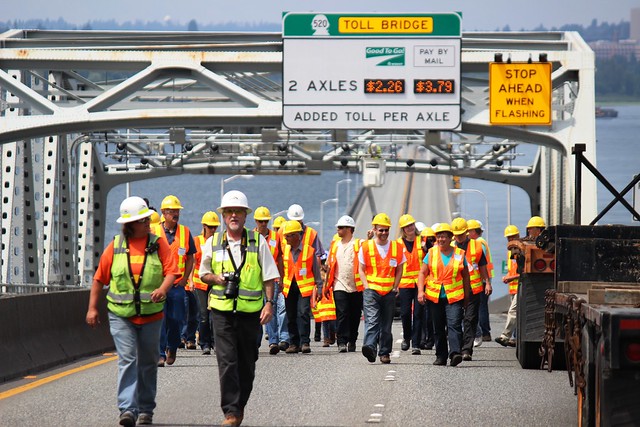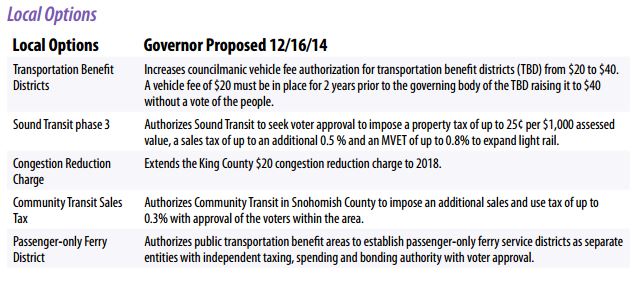
Yesterday, Governor Jay Inslee (D-WA) held a press conference on a new 12-year transportation policy for Washington State. His backdrop for the event was the recently-opened transit center on SR 520. During his press event, the Governor announced his plan for a $12.2 billion statewide multimodal transportation package. The vision for the new transportation policy is focused on maintenance and safety of existing infrastructure, clean air and water, and capital investments in new roads and transit facilities. Inslee stated at the event that:
This is a plan that will keep us safe on the roads, reduce traffic, create jobs and help clean our air and water. This is how we can build a transportation system to move all of Washington State forward.
Funding for the measure would be raised by the issuance of new bonds, increased fees to drivers, and a carbon tax on polluting industries–a huge policy shift for a state that that has traditionally relied on gas tax revenues. The Governor says that he will not be proposing a new gas tax increases.
The transportation crisis is real for Washington State; a whopping 52% decrease in basic maintenance funding is projected over the next 12 years, and at least 71 more bridges will become structurally deficient over that time putting the traveling public at serious risk for new catastrophic bridge collapses like the Skagit River Bridge in 2013. This is of course to say nothing about critical projects that remain entirely unfunded, or services that have been reduced due to the recession.
The plan does provide real benefits to transit and non-motorized users. At least $1.2 billion would be allocated toward a range of alternative transportation modes. Line items identified in the plan, include:
- Transit projects ($162 million)
- Regional Mobility Grant increase ($300 million)
- Complete Streets programs ($117 million)
- Safe Routes to School Grants ($150 million)
- Bike/Ped Grants ($150 million)
The plan further covers things like special needs transit, transit operations, and Commute Trip Reduction programming. Local transportation agencies also would see a share of possible new revenue granted by the proposal. As seen in the table below, a wide range of transportation packages could be enacted by cities and counties across the state. Sound Transit would have an option to go to voters for approval of Sound Transit 3, which would expand rail-based services dramatically in the 3 counties covered by the authority. King County would be entitled to a new Congestion Reduction Charge to benefit public transportation by approval of the County Council through 2018. Water-based counties could also levy new taxes to increase or establish foot-ferry services, like the King County Water Taxi. And, Community Transit would get badly needed authority to increase sales taxes in order to return to pre-recession services, subject to voter approval.

The Governor is passionate about the issue of climate change. His package is considerably more green than past transportation packages have been. The Governor is using this package as an opportunity to provide better alternative transportation commuting options to the traveling public while hitting heavy emitters hard through a carbon tax. Ultimately, consumers will bare the cost of pollution by the purchase of more expensive goods generated from carbon-intensive industry. The package finally makes the State commit to a higher level when it comes to walking, biking, and taking transit.
However, the Governor’s proposed spending is bloated when it comes to funding new transportation investments. 54% of the total transportation package would be allocated to the construction of unnecessary new highway and road expansion projects. $5.8 billion will be spent on numerous megaprojects, including local boondoggles:
- SR 520 expansion ($1.443 billion)
- SR 509 corridor completion ($957 million)
- SR 167 corridor completion ($856 million)
- I-5/JBLM ($278 million)
- I-405 Renton-to-Bellevue ($1.315 billion)
To round out the paved pork, the Governor is further proposing highway expansions in Snohomish County and North Spokane (US 395).
The shortcomings from the Governor’s plan are clear: most of the real benefits to traffic reduction are not guaranteed under the proposal while the investment side of things is actually in inconsistent with the policy’s stated environmental goals. The addition of new pavement will not ease congestion for commuters and the traveling public. In fact, the proposed highway projects will increase gridlock and further come at the cost of transit. New “capacity” for vehicles on the roads will not reduce commute times.
Rather, the Governor’s plans would induce sprawl, increase carbon emissions, and inevitably misallocate local municipal (and state) revenue to fund low density development. Aside from the dollars that the Governor’s plan directly provides for transit, the lionshare of revenues have to be passed at a local. This puts each transit funding option at risk of non-adoption by either councils or voters. In sum, this leaves the Governor’s plan as deeply flawed for the 21st Century transportation that Washington State needs.
For more information on the Governor’s proposal, see his policy document Let’s Move Forward.
Stephen is a professional urban planner in Puget Sound with a passion for sustainable, livable, and diverse cities. He is especially interested in how policies, regulations, and programs can promote positive outcomes for communities. With stints in great cities like Bellingham and Cork, Stephen currently lives in Seattle. He primarily covers land use and transportation issues and has been with The Urbanist since 2014.


